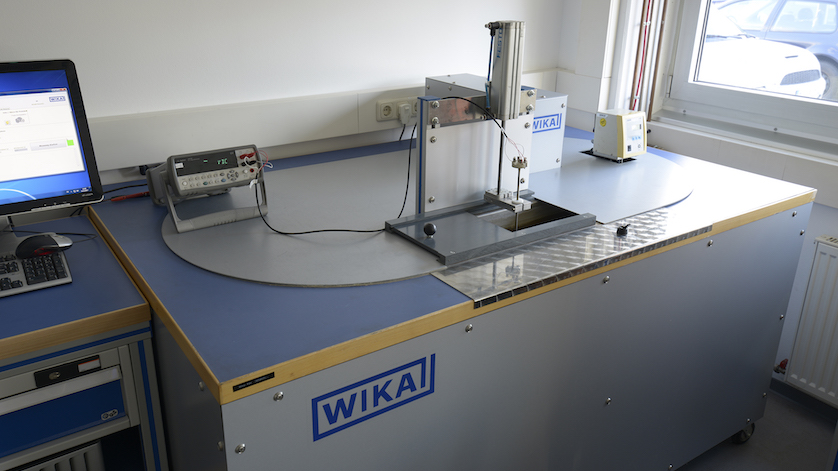
Thermowells protect temperature sensors from harsh media. On the downside, these fittings increase the thermal response time. Therefore, knowing precisely what that response time is becomes a key factor in controlling processes and systems.
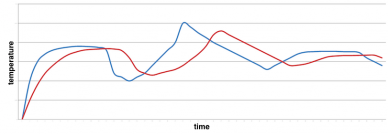
Figure 1: The measured temperature (red curve) always lags behind the actual temperature (blue curve).
In the real world, not even the best thermometer responds instantly to temperature changes in an industrial process. For one, heat in a medium takes time to reach the sensor. There is also the issue of heat dissipation in every part of the measuring system. The measured temperature, therefore, always lags behind the actual temperature. This time difference may be just a few seconds or as long as several minutes, but a delay is inevitable and should be taken into account when choosing temperature systems.
Many factors affect the response time of a temperature measuring system:
- The type, size, and material of the temperature sensor
- How far a sensor is inserted into the medium
- The type of medium (liquid, gas, surface, etc.)
In addition, many industrial processes require that a temperature sensor be placed inside a thermowell, which also increases the response time.
In certain processes, such as hydrocracking, a slow response time can mean big trouble. For example, if the process temperature increases rapidly – a runaway situation – before the sensor is able to detect the change, the temperature could exceed the design limits of the steel vessel and cause a catastrophic failure.
What Is a Thermowell and When to Use One
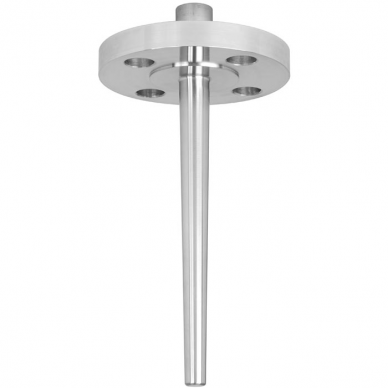
The Model TW10 thermowell with flange is designed for the petrochemical industry.
Thermowells are metal fittings designed to protect temperature sensors. These cylindrical fittings can be made of different materials – stainless steel, copper alloy, heat-resistant steel, etc. – and come in an assortment of sizes and thicknesses, depending on the process. Thermowells are routinely used in pipelines, petrochemical processes, on/offshore applications, compressors, and syngas plants in order to protect electrical thermometers from:
- Corrosive and/or abrasive media
- Fast-moving media
- Extreme pressure
Another benefit of thermowells: They allow technicians to replace, calibrate, and inspect the sensors without interrupting the process.
How Thermowells Affect Temperature Response Times
Adding a thermowell to the temperature measuring system means having another layer of material through which heat must cross, as well as more opportunities for heat to dissipate. The factors that affect response times and accuracy are the thermowell’s material, thickness, and overall size. Wider, thicker-walled thermowells increase heat dissipation.
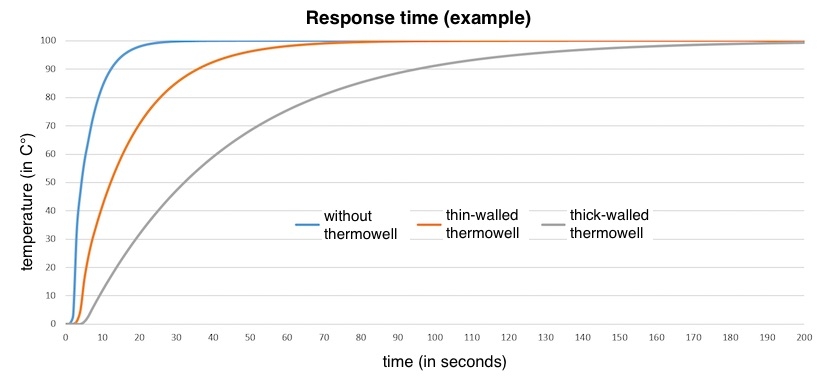
Figure 2: Response times of sensor X without a thermowell (blue curve), in a thin-walled thermowell (orange curve), and in a thick-walled thermowell (gray curve).
The ideal balance could be to simply use a narrow, thin-walled thermowells, which would have a faster response time and better accuracy than a thicker thermowell, but the former may not be robust enough for certain processes. There is a growing call worldwide for thermowell strength calculations, which impacts thermowell design. New versions of standards, such as ASME PTC 19.3 TW-2016, often result in changes to the thermowell dimensions to be shorter and thicker.
How to Measure Thermal Response Times
There are four ways to measure the response time of an electrical thermometer: in flowing water, in flowing air, on a surface, or in a solid body. In North America, the ASTM E644-11 standard (Standard Test Methods for Testing Industrial Resistance Thermometers) and the ASTM E839-11 standard (Standard Test Methods for Sheathed Thermocouples and Sheathed Thermocouple Cable) provide guidelines for temperature measurements.
Other standards for the basis of response time in water or air are based on these standards and directives:
- VDI / VDE 3522 Part 1 (Dynamic behavior of contact thermometers – Principles and characteristic values) and 3522 Part 2 (Dynamic behavior of contact thermometers – Experimental determination of time percentage values)
- IEC 60751, Chapter 3.11 (Definition of thermal response time – Influence of measurement parameters) and Chapter 6.5.2 (Thermal response time)
Let’s take a closer look at measurements in water.
Thermowell Response Time Using the Flowing Water Method
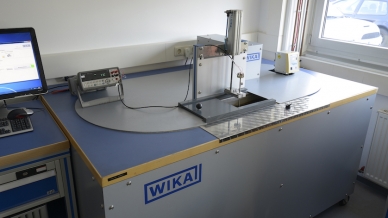
WIKA uses a circulating water bath to measure thermal response times using the flowing water method.
In this test, water is the medium. It moves in a laminar flow (as opposed to a turbulent flow) at a rate of > 0.2 m/s, and is held at a constant temperature. The temperature sensor is very rapidly moved from an ambient initial temperature (T1) of between 41°F and 86°F (5°C and 30°C) to the flowing water at T2. The time it takes to go from T1to T2is measured and recorded.
The test uses three configurations:
- Electrical thermometer without a thermowell
- Electrical thermometer with a thin-walled thermowell
- Electrical thermometer with a thick-walled thermowell
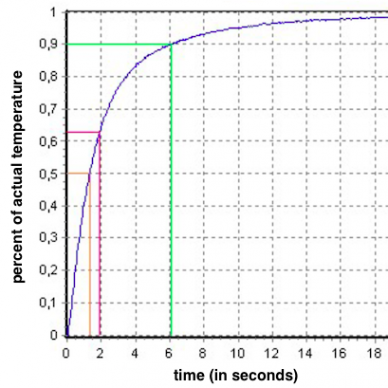
Figure 3: The time it takes to reach 50% (orange), 63% (red), and 90% (green) of actual temperature.
… and measures three comparison thresholds:
- At 50% of actual temperature (t5)
- At 63% of actual temperature (t63)
- At 90% of actual temperature (t9)
A response time diagram is generated from the measurement results. The 100% value is not determined because it is never reached.
How to Select a Thermowell
Applications in the process industry are often very specific and customized, and the response times cannot be compared with those of standard products. If the response time is process-critical, it must first be determined in the laboratory.
The challenge when selecting and designing temperature measuring systems is to reconcile the process parameters and requirements with the best possible performance and lowest possible cost. For critical safety systems, contact the temperature specialists at WIKA USA for expert advice on electrical thermometers, thermowells, and which temperature measurement solutions are right for your processes.


To the wika.us admin, Thanks for the well-researched and well-written post!
Hello wika.us administrator, Your posts are always well written.
Dear wika.us admin, Your posts are always well thought out.